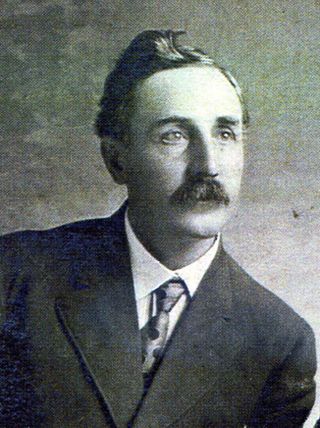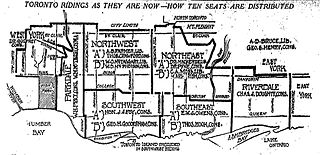There have been various groups in Canada that have nominated candidates under the label Labour Party or Independent Labour Party,or other variations from the 1870s until the 1960s. These were usually local or provincial groups using the Labour Party or Independent Labour Party name,backed by local labour councils made up of many union locals in a particular city,or individual trade unions. There was an attempt to create a national Canadian Labour Party in the late 1910s and in the 1920s,but these were only partly successful.
William Edmund Newton Sinclair,known as W. E. N. Sinclair,was a Canadian barrister,solicitor and interim leader of the Ontario Liberal Party.
The Liberal–Labour banner has been used several times by candidates in Canadian elections:
Leopold Macaulay was a Canadian politician and lawyer,born in Peterborough,Ontario.

Bellwoods was a provincial riding in Ontario,Canada in the old City of Toronto's west-end. It was represented in the Legislative Assembly of Ontario from 1926 until 1987,when it was abolished and redistributed into the Dovercourt,and Fort York districts.

Eglinton was a provincial electoral district located in Toronto,Ontario. From 1926 until 1999 it elected members to the Legislative Assembly of Ontario. At its abolishment in 1999 it consisted of the neighbourhoods of Davisville and Lawrence Park in the north end of the old city of Toronto. It was abolished into Eglinton—Lawrence,Don Valley West and St. Paul's.
Durham West was an electoral riding in Ontario,Canada. It was created in 1867 at the time of confederation. It contained the towns of Pickering and Ajax.

St. George was a provincial riding in Ontario,Canada,that returned Members of Provincial Parliament (MPPs) to the Legislative Assembly of Ontario at Queen's Park. It was created in downtown Toronto in 1926 and was merged into the riding of St. George—St. David in 1987. The seat covered much of the city's central core,roughly similar to the current riding of Toronto Centre. At its dissolution it stretched from University Avenue to Parliament Street and from the waterfront north past St. Clair.

St. David was an Ontario provincial riding that existed from 1926 to 1987. It covered a section of the eastern city of Toronto east of Sherbourne Street and west of the Don River. The riding lasted until 1987 when it was merged with the neighbouring St. George to create a larger district called St. George—St. David.

Herbert Henry Ball was a Canadian politician and journalist.

Humber River—Black Creek is a provincial electoral district in Ontario,Canada,that has been represented in the Legislative Assembly of Ontario since 1999. Prior to the 2018 election,the riding was known as York West.
York East was a provincial electoral district in Ontario,Canada. It was formed in 1867,the same year as the beginning of the country and it elected members up until 1999 when it was dissolved. Initially it covered a large swath of territory stretching from Lake Ontario north to Richmond Hill. It was formed based on the eastern part of the county of York. Over time as the population increased,the territory was reduced. By the late 1950s it represented only a portion of the borough of East York,a small municipality on the edge of Toronto. In 1999 it was abolished and its remaining territory was distributed between Beaches—East York and Don Valley West ridings.

Beaches was a provincial riding in Toronto,Ontario represented in the Legislative Assembly of Ontario from 1926 to 1967. It was carved completely out of the existing riding of York East. Its boundaries remained the same until 1967 when it was merged with the neighbouring riding of Woodbine to become Beaches—Woodbine. Other than a single session in the 1940s,the riding was steadfastly Conservative in its voting preference.

Toronto Northeast was an Ontario provincial electoral district that existed from 1914 to 1926. It occupied an area north of College and Gerrard between University and Logan Ave. In 1926 there was a major redistribution of Ontario seats which resulted in Toronto Northeast being split between four new ridings called St. Patrick,St. George,St. David,and Eglinton.

Toronto Northwest was an Ontario provincial electoral district that existed from 1914 to 1926. It occupied an area north of College and Gerrard between Lansdowne and Spadina. In 1926 there was a major redistribution of Ontario seats which resulted in Toronto Northwest being split between five new ridings called from west to east,Brockton,Dovercourt,Bellwoods,St. Andrew,and St. Patrick.
York North was a provincial riding in Ontario,Canada,that was represented in the Legislative Assembly of Ontario from 1867 to 2007. The provincial riding was known as York—Mackenzie from 1995 to 1999.
Simcoe South was an electoral riding in Ontario,Canada. It was created in 1867 at the time of confederation and was abolished in 1933 before the 1934 election.
Wellington was an electoral riding in Ontario,Canada. It existed in various incarnations and names throughout its existence. It started as Wellington North in 1867 but was abolished in 1879 after only three terms. It was re-established as Wellington Northeast in 1926 and then changed to Wellington North in 1934 which existed until 1955 when it became Wellington-Dufferin. The name was changed again in 1975 to become Wellington-Dufferin-Peel. In 1987 it underwent its final name change to Wellington until 1999 when it was abolished into Waterloo—Wellington before the 1999 election.
Northumberland East was an electoral riding in Ontario,Canada. It was created in 1867 at the time of confederation and was abolished in 1925 before the 1926 election. It was merged with Northumberland West to form Northumberland.



